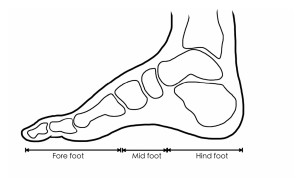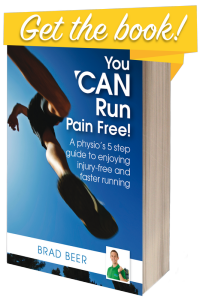Running Technique Principle 3: Optimise Your Foot Placement
Running Technique Principle 3: Optimise Your Foot Placement
The third principle of great running technique is to ensure the correct part of your foot comes into contact with the ground.
The Foot: Structure and Function
The foot is an amazingly created and biomechanically complex structure. Twenty-six bones (one-quarter of the total number of bones in a human), thirty-three joints, and more than 100 muscles, tendons and ligaments are found in the human foot.
The foot has three regions: the forefoot, which contains the metatarsal and phalange (toe) bones; the rear-foot, which contains two of the seven tarsal bones; and the mid-foot, which contains the remaining five tarsal bones. The mid-foot, as the name suggests, is the middle of the foot between the forefoot (toes) and rear-foot (heel).
See the following diagram to locate these three regions.
Which part of the foot should a runner land on?
In order to best maximise the likelihood of running pain and injury free, and faster, a runner’s foot should ideally make contact at the mid-foot or forefoot. As with minimising bopping motion (great running technique principle 2), running with a correct cadence of 90 single steps/min is the best way to achieve optimal foot placement on foot landing. If a runner concentrates on running with a cadence of 90 single steps/min, their foot is likely to land on a better part of the foot (that is, the forefoot or the mid-foot) than if they are over-striding.
Running w a cadence of 90 Steps/min is the best way 2 achieve optimal foot placement #runpainfree #run #protip Share on X
(To learn more about Great running technique principle 1: Do not over-stride click HERE.)
It is debatable as to whether sufficient research exists to validate the theory that forefoot or mid-foot strikes are less injurious compared with their heel strike counterpart. Many would argue that data is insufficient to conclusively prove that heel striking increases injury risk. Very few studies have actually looked at the difference in injury rates between forefoot, mid-foot, and heel striking runners.
What about heel-striking?
In terms of a reduced injury risk, however, several studies have yielded results that favour forefoot or mid-foot strike patterns over heel striking. One study found that runners who habitually land on their heel (rear-foot strike) incurred a greater degree of repetitive stress injuries (such as shin splints) compared with runners who mostly landed on the front of their foot fore-foot.[i] The 2012 study of Division 1 cross country runners found heel strikers had twice the rate of injuries when compared with mid-foot and forefoot strikers.[ii]
Landing with a concurrent mid-foot and heel contact is also a preferred foot placement as opposed to a heel strike. This concurrent foot strike, where the heel lands concurrently with the forefoot, is one of the hallmark teachings of the Chi Running technique method. Chi runners are instructed to aim for a ‘flat foot’ foot contact, whereby the forefoot and rear-foot make ground contact in concert with one another.
The problems with heel-striking
Problems occur when a runner lands repeatedly on their heels – which is what happens with over-striding. When the heels are the first point of contact, the runner’s natural ‘shock absorbers’ are bypassed, and they encounter ground reaction forces that travel up the leg. Hitting the ground with a stiff leg also requires extra energy output at every stride to overcome the ‘braking force’ that the ground exerts on the runner’s body.
When the heels are the first point of contact, the runner’s natural ‘shock absorbers’ are bypassed #runpainfree #runtechnique #running #physio Share on X
On impact, the bones of the foot and supporting soft tissues move in concert to dissipate and lessen the loads encountered upon landing. The plantar fascia softens and the foot joints ‘splay’ in order to minimise the load on the foot. This in turn minimises the load that is passed up the body to other structures such as the achilles tendon, claves, knees, hamstrings and quadriceps, hip and, ultimately, the lower back. In contrast, the heel doesn’t have any of these shock-minimising or shock absorptive features.
The overstriding and heel-striking runner dangerously bypasses their foot’s ‘built-in’ shock absorbers and, because they’re not using these natural shock absorbers, they go on to run slower and with a much higher injury risk.
Tips for optimising your foot placement
In order to optimise your foot placement try the following:
- Ensure your running cadence is 90 single steps/min. Click HERE for more information on how to run with correct cadence.
- Practise the below drill: bounce on your heels ten times (this feels horrible and uncoordinated), bounce on your tippy toes ten times (very fatiguing), and then bounce in-between these two extremes (that is, between the tips of your toes and the heel). What you are landing on here is the mid-foot, and this is the foot contact position you should experience when you run.
Where possible avoid heel-striking
If you are not yet convinced of the perils of failing to optimise your foot placement on landing, take a hammer and repeatedly bang it on your heel bone. If you run an average of 30 kilometres a week, this will be equivalent to 1.5 million heel strikes or hammer blows. Ouch! It is little wonder that runners who do not optimise their foot placement get injured. The take-home message is simple: where possible avoid heel striking. The heel is merely covered by skin and is not a shock-absorbing anatomical structure.
The take-home message is simple: where possible avoid heel striking! #runpainfree #physio #runpainfreebook Share on X
It should be noted that even some of the fastest and most apt runners still land heel first. In fact, when the top 20 American male and female 10-kilometre track runners were analysed with high definition video analysis at the US 2012 Olympic trials, four of the top 20 men and five of the top 20 women were found to have a heel strike landing. This proves that even at the level of elites, foot striking varies. It also proves that you can still run fast even with a heel strike.
However, if I was coaching an injured runner on how to best get back from injury or indeed a runner who was keen to avoid injury, I would always recommend a forefoot or mid-foot landing over a heel strike landing.
It should also be noted that only focusing on foot strike modification when attempting to modify running technique is myopic and ignores the interdependence of the other four principles. Lastly it is important to not consciously try and manipulate your foot placement when running. I have observed that this tends to result in toe running as runners consciously try and get ‘off their heels’. It is much more effective to concentrate on cadence first as this from my experience results in the foot landing in the ‘sweet spot’ in a mid-foot strike.
If you have any comments or questions please leave them in the comments below.
Yours In Running,
Brad Beer (APAM)
Physiotherapist, Runner, Author ‘You CAN Run Pain Free!‘
Note: The above is an extract from my AMAZON Running & Jogging Bestseller ‘You CAN Run Pain Free!’ available for purchase of paper copy HERE or digitally via AMAZON. Read what readers are saying HERE.
References
[i] Daoud, A, Geissler, G, Wang, F, Saretsky J, Daoud Y, Lieberman D. 2012. ‘Foot strike and injury rates in endurance runners: a retrospective study’. Med Sci Sports Exer, 44 (7): 1325–34.
[ii] ibid
If you are ready to say goodbye to your running injury and ‘hello’ to your best injury-free running performance schedule your Discover Recover Session HERE.











Hi Brad,
Great article.
Got a question for you, with regards to the recommended optimal cadence (90 steps/min – single); how does some one maintain this for different speed/efforts? For example if i am doing 70% effort compared to a 80% or 90%, will the cadence vary as well?
Thanks,
Juan